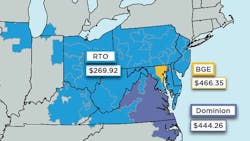PJM Interconnection’s Capacity Auction Secures Resources to Meet RTO Reliability Requirement for 2025-2026
PJM Interconnection’s capacity auction, called the Base Residual Auction (BRA), has secured resources to meet the RTO reliability requirement for the 2025-2026 delivery year.
Auction prices were higher across the RTO due to decreased electricity supply caused primarily by a large number of generator retirements, combined with increased electricity demand and implementation of FERC-approved market reforms. Two zones were short of their reserve requirement, resulting in prices set at the zonal cap, while the overall resource mix is adequate.
The auction cleared a diverse mix of resources, including 48% of gas, 21% of nuclear, 18% of coal, 1% of solar, 1% of wind, 4% of hydro, 5% of demand response and 2% from other resources.
The drivers of higher prices in the auction include:
· Decreased supply offers into the auction due mainly to generator retirements
· Increase in projected peak load
· FERC-approved market reforms, including improved reliability risk modeling for extreme weather and accreditation that more accurately values each resource's contribution to reliability
The amount of supply resources in the auction decreased in 2024 demonstrating PJM's stated concerns (PDF) about generation resources under pressure to retire without replacement capacity being built quickly to replace them. Approximately 6,600 MW of generation have retired or have must-offer exceptions (signaling intent to retire) compared with the generators that offered in the 2024-2025 BRA.
The peak load forecast has increased from 150,640 MW for the 2024-2025 BRA to 153,883 MW for the 2025-2026 delivery year. Additionally, FERC-approved market reforms contributed to tightening the supply and demand balance by better estimating the impact of extreme weather on load and more accurately determining resource reliability value.
The North American Electric Reliability Corporation has identified higher risk to the reliability of the electrical grid for much of the country outside of PJM.
PJM is implementing its FERC-approved generation interconnection reform, with approximately 72,000 MW of resources expected to be processed in 2024 and 2025, to facilitate the entry of new resources.
Currently, about 38,000 MW of resources have cleared PJM's interconnection queue but are not built due to external challenges, including financing, supply chain and siting/permitting issues.
PJM's capacity market, or Reliability Pricing Model, is one of multiple wholesale electricity markets managed by PJM, with day-ahead and real-time energy markets accounting for the majority of total costs.
The auction produced a price of $269.92/MW-day for much of the PJM footprint, compared to $28.92/MW-day for the 2024/2025 auction. The 2024 auction procured 135,684 MW for the period of June 1, 2025, through May 31, 2026. The total Fixed Resource Requirement (FRR) obligation is an additional 10,886 MW for a total of 146,570 MW.
The total procured capacity in the auction and resource commitments under FRR represents an 18.5% reserve margin, compared to a 20.4% reserve margin for the 2024-2025 delivery year.
Prices are higher, at the zonal cap, in the BGE zone in Maryland and the Dominion zone in Virginia and North Carolina due to insufficient resources in these regions and constraints on the transmission system limiting the ability to import capacity. The prices indicate that these regions will benefit from either additional resources, additional transmission to allow increased imports into those regions, or a combination of the two.
The next BRA, for the 2026-2027 delivery year, is scheduled for December 2024.
